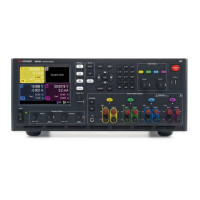Negative values represent data samples taken prior to the trigger. This lets you acquire measurement
samples prior to the trigger.
If, during a pre-trigger data acquisition, a trigger occurs before the pre-trigger data
count is completed, the measurement system ignores this trigger. This will prevent the
completion of the measurement if another trigger is not generated.
Specify a Window Function
Windowing is a signal conditioning process that reduces the error in average measurements made in
the presence of periodic signals and noise. Two window functions are available: Rectangular and
Hanning. At power-on, the measurement window is Rectangular.
The Rectangular window calculates average measurements without any signal conditioning.
However, in the presence of periodic signals such AC line ripple, a Rectangular window can introduce
errors when calculating average measurements. This can occur when a non-integral number of cycles
of data has been acquired due to the last partial cycle of acquired data.
One way of dealing with AC line ripple is to use a Hanning window. The Hanning window applies a cos4
weighting function to the data when calculating average measurements. This attenuates the AC noise
in the measurement window. The best attenuation is achieved when at least three or more waveform
cycles are in the measurement.
To select the Hanning window function, use:
SENS:WIND HANN,(@1)
Select the Measurement Trigger Source
A TRIGger:ACQuire[:IMMediate] command over the bus will always generate an
immediate measurement trigger, regardless of the selected trigger source.
Unless you are using a TRIGger:ACQuire command to trigger the measurement, select a trigger
source from the following:
BUS Selects GPIB device trigger, *TRG, or <GET> (Group Execute Trigger)
CURRent<1-4> Triggers the measurement when the current of the corresponding outputpasses through the specified level.
EXTernal Selects the trigger input BNC connector. Requires a low-true trigger signal.
PIN<1-7> Selects a specific pin thatis configured as a Trigger Input on the digital port. The selected pin mustbeconfigured as a
Trigger Input in order to be used as a trigger source (see Using the Digital Port).
TRANsient<1-4> Selects the specified output channel’s transientsystem as the trigger source.
VOLTage<1-4> Triggers the measurement when the voltageof the corresponding output passes through the specified level.
Use the following commands to select a trigger source. To select Bus triggers for output 1:
TRIG:ACQ:SOUR BUS,(@1)
Keysight N6705C Operating and Service Guide 203
6 Advanced Source, Measurement, and Control

